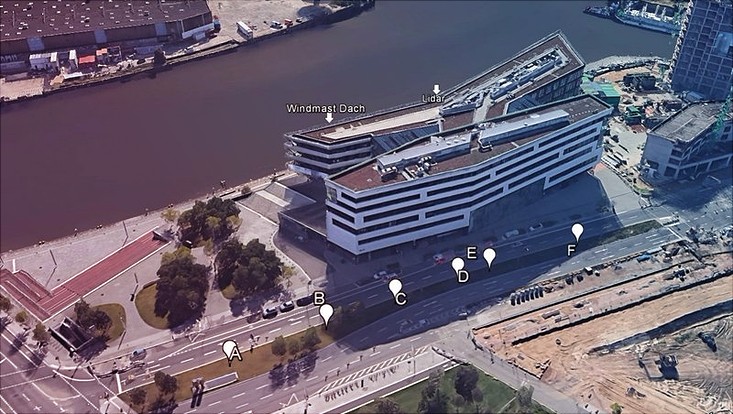How building change the wind in the HafenCity
26 September 2017, by CEN Universität Hamburg

Photo: UHH/Meteorologisches Institut
Instead of being windless, for pedestrians it is often especially windy near tall buildings, as they can markedly change the air currents in their immediate vicinity. How does the construction of a new building concretely influence wind direction and speed? Is more exhaust gas funneled into certain areas? How can gale-force winds and storms in winter and mild summertime breezes be measured in all their dimensions? Researchers are currently exploring these and other questions in the project “Meteorological Drive and Urban Modification.”

“Last week our team from the Meteorological Institute successfully completed a four-week measuring campaign for the project in Hamburg’s HafenCity,” says Dr. Sarah Wiesner. Anyone who was underway here in the past few weeks couldn’t help but notice the six seven-meter-tall wind-measuring masts on the street in front of the HafenCity University (HCU). “By gathering data along the Überseeallee, we’ve gained excellent insights into how differently the wind can blow at the micro level. This also marks the first time we’ve measured the wind on top of and around buildings,” explains Wiesner. To do so, the team measured in all potential directions from which the wind can blow. “The HafenCity is currently undergoing a transformation, and is particularly interesting because much more of it has yet to be built.” Accordingly, the team will also compare past readings from last winter with the latest ones, and with further measurements that will follow next winter. “A few more buildings have popped up in the meantime, and we want to see how this has affected the wind.”
In addition, they installed a wind LIDAR – a laser-based device that can measure wind speeds up to 1,000 meters above the ground – on the roof of the HCU building. And it’s not alone: a ten-meter-tall measuring mast has also been installed there. “To find the ideal measuring locations, my colleagues from the Universität Hamburg’s Wind Tunnel Laboratory conducted tests with miniature versions of the district and its buildings in advance,” says Sarah Wiesner.
The campaign is part of a series in the context of the Federal Ministry of Education and Research (BMBF) program “Urban Climate Under Change” [UC]². In the related project “Three-dimensional Observation of Atmospheric Processes in Cities” (3DO), a variety of datasets on the atmosphere in Berlin, Hamburg and Stuttgart will be gathered. In this regard, especially long-term observations are expected to yield valuable data that can not only improve climate models, but also be used directly in urban planning and air-quality monitoring. The ultimate goal is to develop an innovative urban climate model – which will above all benefit urban planners, providing extensive information as a basis for construction-related decisions.
Further information
